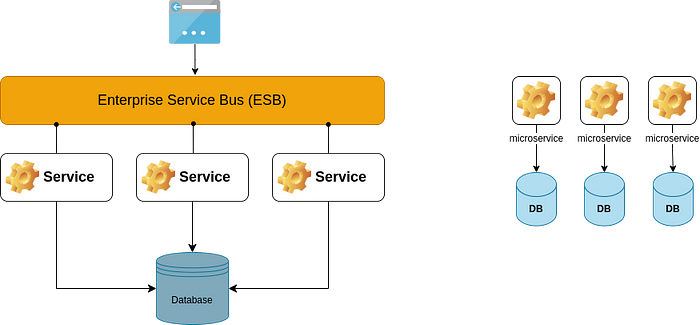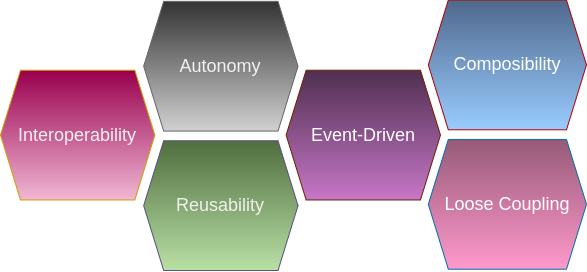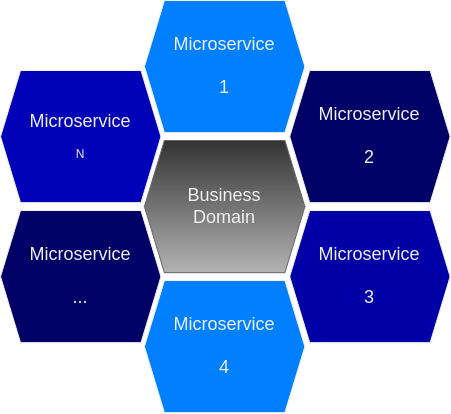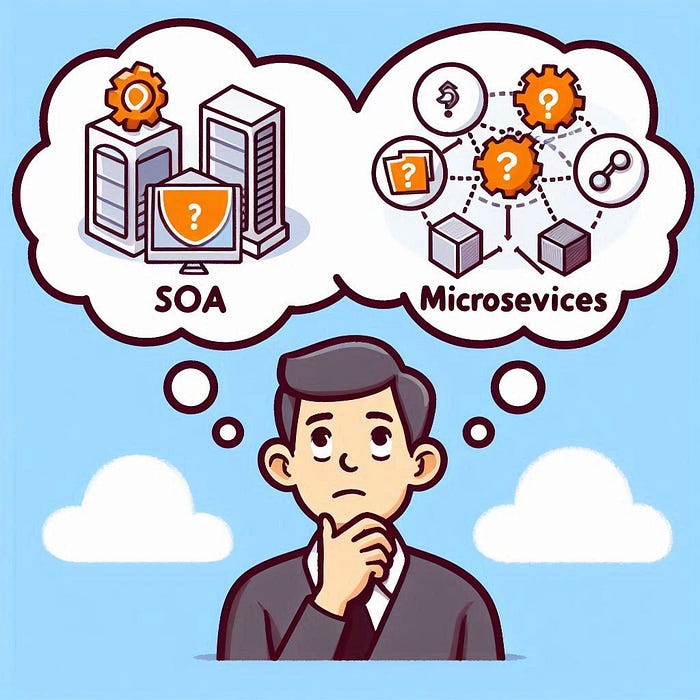Moving Towards Granularity with SOA and Microservices
 Hamid Ghorashi
Hamid Ghorashi
In the constantly changing world of software development, organizations are finding themselves constrained by the limitations of monolithic applications. These large, interconnected systems, which once worked well, are now major obstacles in a world that needs flexibility, scalability, and quick innovation. The ability to adapt quickly to market changes, adopt new technologies, and update systems smoothly is more crucial than ever.
Service-Oriented Architecture (SOA) and microservices are two approaches that break monolithic applications into smaller and more manageable parts. By focusing on modularity and granularity, these methods produce more responsive and resilient systems, allowing development teams to work more independently and efficiently.
This article explains why it’s important to move from monolithic applications to more granular architectures. We’ll look at the problems these approaches solve, their benefits, and their drawbacks. By understanding the advantages of decentralization and modular design, organizations can better meet the demands of modern software development and provide greater value to their users.
Microservices vs. SOA: Balancing the Trade-Offs
As mentioned earlier, SOA and microservices have emerged as powerful paradigms to address the limitations of traditional monolithic applications. SOA, an older concept, focuses on creating services that can work together over a network, often using a central enterprise service bus (ESB) for communication and integration. Microservices take this idea further by splitting services into even smaller, independently deployable units that communicate directly with each other, typically via lightweight protocols like HTTP/REST. Here we list some of the differences between these two approaches:
Scope:
The primary difference between the two approaches comes down to scope. In straightforward terms, service-oriented architecture (SOA) operates on an enterprise level, whereas microservices architecture focuses on an application level.

Fault tolerance:
Since SOA utilizes a centralized service bus for communication between services, a service failure can have broader impacts due to the tighter coupling. In contrast, failing a service in microservice architecture doesn’t necessarily impact others and it offers a better fault isolation.
Speed:
By leveraging the benefits of a shared architecture, SOAs streamline development and troubleshooting. However, this shared approach often results in slower operation compared to microservices architectures, which prioritize duplication over sharing to enhance performance.
Data storage:
SOA and microservices differ in terms of how to allocate storage resources. In SOA architecture, there is typically a single data storage layer shared by all services, whereas microservices architecture provides dedicated data storage for each individual service, isolating the data within each small service.

Intercommunication:
To simplify operations, microservices rely on lightweight communication protocols such as HTTP/REST (Representational State Transfer) and JMS (Java Messaging Service). In contrast, SOAs embrace a broader range of communication protocols, including SOAP (Simple Object Access Protocol), AMQP (Advanced Messaging Queuing Protocol), and MSMQ (Microsoft Messaging Queuing).
Scalability: Microservices provide high scalability due to their granular and fine-grained architecture, allowing each service to be scaled independently according to demand. However, the decentralized nature of this architecture brings challenges in managing distributed transactions and ensuring data consistency. SOA also supports scaling but it may require more effort to handle and expand the larger services. Coarse-grained services could cause over-scaling since the entire service has to scale up even if only certain parts are experiencing heavy loads.
SOA design principles
It is crucial to follow specific principles when designing an architecture. In the context of Service-Oriented Architecture (SOA), these principles serve as guidelines not only for the inception of new services but also for refining and optimizing existing ones.
The following are some principles that might be closely related and complementary.

Services should be built on common standards: This involves using standard protocols and formats for communication and data exchange. Ensuring service interoperability in a service-oriented architecture (SOA) is like conducting a symphony where each musician (service) plays a different instrument (technology).
Services Should Own Data: In SOA, services should have ownership over both reads and writes to their own data. This principle promotes data consistency, encapsulation, and isolation, ensuring that multiple services access data through a gatekeeper service’s API. This approach helps prevent dependencies and encourages focused, non-duplicative service functionality.
Services Should Address Specific Concerns: SOA aims to avoid creating either monolithic or overly fragmented architectures. Instead, services should address specific concerns, striking a balance between scope and focus. The goal is to break apart monolithic systems into appropriately sized services that encapsulate related functionality without creating unnecessary dependencies or duplicating code.
Data Mutations Should Publish via Standard Events: In SOA, data mutations should trigger standard events that are published to a queue, enabling other services to consume and react to these events. This approach replaces callback methods commonly used in monolithic architectures with a standardized event-driven model. For example, Airbnb developed SpinalTap, a Change Data Capture service, to capture database changes and publish them to Kafka, allowing other services to react accordingly based on the published events.
Dependencies between services should be minimized: The concept of loose coupling is a fundamental design principle in service-oriented architecture (SOA), as it leads to the reduction of dependencies between components. This enables them to operate independently and be easily replaced or updated without affecting other parts of the system.
Services should be crafted for reusability: This implies that for maximized reuse, logic is broken down into services. Once the code for an individual service is built, it should be able to function with different kinds of applications.
In conclusion, SOA design requires adherence to key principles to create and optimize services effectively. We outlined five crucial principles: Interoperability, Autonomy, Composabilty, Event-Driven, Loose Coupling, and Reusability. Adhering to these principles results in a scalable, maintainable, and reliable system.
Microservices design principles
As previously mentioned, microservices advocate for smaller, fine-grained services that are narrowly focused on specific business capabilities. Each microservice is designed to perform a single function or process, and they are often organized around specific business domains or functionalities. This focused approach, however, introduces greater complexity during the design of microservices architecture compared to SOA.

The design of microservices should incorporate these fundamental principles:
Every microservice should be self-contained and should operate independently: Each service should possess its own resources, including separate databases and business logic, ensuring it can perform its functions without depending on other services. The core concept of this principle is to ensure that each service can be developed, tested, and deployed independently, without impacting other parts of the system.
Services should be scaled independently based on their specific demands: Instead of scaling an entire monolithic application, only the microservices that experience increased load or require more resources are scaled. This fine-grained scalability means that resources can be allocated more efficiently, improving performance and reducing costs. Additionally, because microservices can be deployed across multiple servers or cloud instances, it enables horizontal scaling, where multiple instances of a service run concurrently.
Services should have the required resources to operate efficiently: Auto-provisioning ensures that each microservice automatically receives the necessary infrastructure, including CPU, memory, and storage, tailored to its specific needs. This dynamic allocation of resources allows services to scale in response to real-time demand, optimizing performance and minimizing downtime. By automating resource management, auto-provisioning reduces manual intervention, streamlines deployment processes, and enhances the overall agility and reliability of the system. This approach not only supports efficient operation but also fosters rapid development and iteration, crucial for maintaining competitive and responsive applications.
Real-time load balancing should be implemented to distribute traffic efficiently: Real-time load balancing ensures that incoming traffic is distributed evenly across multiple instances of microservices. This prevents any single service instance from becoming a bottleneck and enhances overall system performance and reliability. By dynamically adjusting to traffic patterns and redistributing workloads as needed, real-time load balancing improves response times, minimizes latency, and ensures high availability. This approach is essential for maintaining the seamless operation of services, especially under variable and unpredictable load conditions.
Microservices should be isolated to prevent cascading failures: Isolating microservices is crucial for preventing failures in one service from affecting others. By using techniques such as circuit breakers, bulkheads, and timeouts, each microservice can be protected from cascading failures. This ensures that issues in one part of the system do not propagate and cause widespread disruption. Isolation enhances system resilience and reliability, allowing other services to continue operating normally even when some services encounter problems. This approach helps maintain overall system stability and ensures that critical functionalities remain available during partial failures.
Overally, creating a robust microservices architecture demands following key principles: each service being self-contained and independent, scalability at a granular level, efficient resource provisioning, real-time load balancing, and isolation to prevent failures from spreading. These principles improve flexibility, reliability, and performance, facilitating swift development and deployment. Despite the complexities involved, these attributes of agility and resilience render microservices essential in contemporary software development.
Deciding between the two architectures

To effectively choose between Service-Oriented Architecture (SOA) and microservices, organizations should consider several factors tailored to their specific needs and operational context.
Evaluate the scope of the application and the level of integration required SOA excels in managing enterprise-wide services through a centralized approach, whereas microservices are optimal for applications requiring fine-grained, independent service units.
Assess the scalability requirements Microservices offer granular scalability by scaling individual services based on demand, while SOA requires careful management to scale larger, more tightly coupled services.
Consider data management SOA typically utilizes a shared data layer across services, whereas microservices prefer isolated data stores per service, enhancing autonomy and minimizing dependencies.
Evaluate the operational complexity Microservices provide flexibility but require robust management of distributed systems, whereas SOA simplifies integration but may introduce complexity in shared services.
By weighing these factors against organizational priorities and project goals, businesses can make an informed decision to adopt the architecture that best aligns with their needs for agility, scalability, and resilience in software development.
References
Subscribe to my newsletter
Read articles from Hamid Ghorashi directly inside your inbox. Subscribe to the newsletter, and don't miss out.
Written by
Hamid Ghorashi
Hamid Ghorashi
I am Hamid Ghorashi a Senior PHP Developer passionate about building dynamic and efficient web applications.